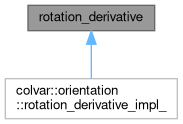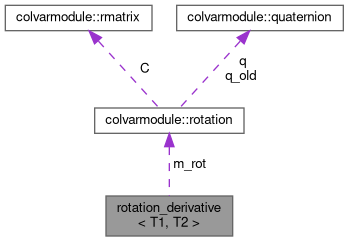Helper class for calculating the derivative of rotation. More...
#include <colvar_rotation_derivative.h>


Public Member Functions | |
| rotation_derivative (const cvm::rotation &rot, const cvm::ag_vector_real_t &pos1, const cvm::ag_vector_real_t &pos2, const size_t num_atoms_pos1, const size_t num_atoms_pos2) | |
| Constructor of the cvm::rotation::derivative class for SOA. More... | |
| void | prepare_derivative (rotation_derivative_dldq require_dl_dq) |
This function must be called before calc_derivative_wrt_group1 and calc_derivative_wrt_group2 in order to prepare the tmp_Q0Q0 and tmp_Q0Q0_L. More... | |
| template<bool use_dl, bool use_dq, bool use_ds> | |
| void | calc_derivative_impl (const cvm::rvector(&ds)[4][4], cvm::rvector *_noalias const dl0_out, std::array< cvm::rvector, 4 > *_noalias const dq0_out, std::array< std::array< cvm::rvector, 4 >, 4 > *_noalias const ds_out) const |
| Actual implementation of the derivative calculation. More... | |
| template<bool use_dl, bool use_dq, bool use_ds> | |
| void | calc_derivative_wrt_group1 (size_t ia, cvm::rvector *_noalias const dl0_1_out=nullptr, std::array< cvm::rvector, 4 > *_noalias const dq0_1_out=nullptr, std::array< std::array< cvm::rvector, 4 >, 4 > *_noalias const ds_1_out=nullptr) const |
Calculate the derivatives of S, the leading eigenvalue L and the leading eigenvector Q with respect to m_pos1 More... | |
| template<bool use_dl, bool use_dq, bool use_ds> | |
| void | calc_derivative_wrt_group2 (size_t ia, cvm::rvector *_noalias const dl0_2_out=nullptr, std::array< cvm::rvector, 4 > *_noalias const dq0_2_out=nullptr, std::array< std::array< cvm::rvector, 4 >, 4 > *_noalias const ds_2_out=nullptr) const |
Calculate the derivatives of S, the leading eigenvalue L and the leading eigenvector Q with respect to m_pos2 More... | |
| template<int i> | |
| cvm::rmatrix | project_force_to_C_from_dxdqi (cvm::real f_on_q) const |
| Project the force on \(q_i\) (or the gradient of \(\frac{\mathrm{d}x}{\mathrm{d}q_i}\)) to the force on the correlation matrix \(C=\mathbf{r}_1^\intercal\mathbf{r}_2\), where \(\mathbf{r}_1\) and \(\mathbf{r}_2\) are \(N\times 3\) matrices containing the atom positions of atom group 1 and atom group 2 after centering on origin. More... | |
| template<typename dim4_array_t > | |
| cvm::rmatrix | project_force_to_C_from_dxdq (const dim4_array_t &sum_dxdq) const |
| Project the force on \(\mathbf{q}\) (or the gradient of \(\frac{\mathrm{d}x}{\mathrm{d}q_i}\)) to the force on the correlation matrix \(C=\mathbf{r}_1^\intercal\mathbf{r}_2\), where \(\mathbf{r}_1\) and \(\mathbf{r}_2\) are \(N\times 3\) matrices containing the atom positions of atom group 1 and atom group 2 after centering on origin. More... | |
| cvm::rvector | project_force_to_group1 (size_t ia, const cvm::rmatrix &dxdC) const |
| Project the force on the correlation matrix \(C\) to \(\mathbf{r}_1\). More... | |
| cvm::rvector | project_force_to_group2 (size_t ia, const cvm::rmatrix &dxdC) const |
| Project the force on the correlation matrix \(C\) to \(\mathbf{r}_2\). More... | |
Public Attributes | |
| const cvm::rotation & | m_rot |
| Reference to the rotation. | |
| cvm::ag_vector_real_t::const_iterator | pos1x |
| Reference to the atom positions of group 1. | |
| cvm::ag_vector_real_t::const_iterator | pos1y |
| cvm::ag_vector_real_t::const_iterator | pos1z |
| cvm::ag_vector_real_t::const_iterator | pos2x |
| Reference to the atom positions of group 2. | |
| cvm::ag_vector_real_t::const_iterator | pos2y |
| cvm::ag_vector_real_t::const_iterator | pos2z |
| size_t | m_num_atoms_pos1 |
| Number of atoms in group1 (used in SOA) | |
| size_t | m_num_atoms_pos2 |
| Number of atoms in group1 (used in SOA) | |
| cvm::real | tmp_Q0Q0 [4][4] |
| Temporary variable that will be updated if prepare_derivative called. | |
| cvm::real | tmp_Q0Q0_L [4][4][4] |
Detailed Description
Helper class for calculating the derivative of rotation.
Constructor & Destructor Documentation
◆ rotation_derivative()
|
inline |
Constructor of the cvm::rotation::derivative class for SOA.
- Parameters
-
[in] rot The cvm::rotation object (must have called calc_optimal_rotationbefore callingcalc_derivative_wrt_group1andcalc_derivative_wrt_group2)[in] pos1 The atom positions of group 1 [in] pos2 The atom positions of group 2 [in] num_atoms_pos1 The number of atoms in group1 [in] num_atoms_pos2 The number of atoms in group2
Member Function Documentation
◆ calc_derivative_impl()
|
inline |
Actual implementation of the derivative calculation.
- Parameters
-
[in] ds The derivative of matrix S with respect to an atom of either group 1 or group 2 [out] dl0_out The output of derivative of L [out] dq0_out The output of derivative of Q [out] ds_out The output of derivative of overlap matrix S
◆ calc_derivative_wrt_group1()
|
inline |
Calculate the derivatives of S, the leading eigenvalue L and the leading eigenvector Q with respect to m_pos1
- Parameters
-
[in] ia The index the of atom [out] dl0_1_out The output of derivative of L with respect to ia-th atom of group 1 [out] dq0_1_out The output of derivative of Q with respect to ia-th atom of group 1 [out] ds_1_out The output of derivative of overlap matrix S with respect to ia-th atom of group 1
◆ calc_derivative_wrt_group2()
|
inline |
Calculate the derivatives of S, the leading eigenvalue L and the leading eigenvector Q with respect to m_pos2
- Parameters
-
[in] ia The index the of atom [out] dl0_2_out The output of derivative of L with respect to ia-th atom of group 2 [out] dq0_2_out The output of derivative of Q with respect to ia-th atom of group 2 [out] ds_2_out The output of derivative of overlap matrix S with respect to ia-th atom of group 2
◆ prepare_derivative()
|
inline |
This function must be called before calc_derivative_wrt_group1 and calc_derivative_wrt_group2 in order to prepare the tmp_Q0Q0 and tmp_Q0Q0_L.
- Parameters
-
[in] require_dl_dq Require the calculation of the derivatives of L or/and Q with respect to atoms.
◆ project_force_to_C_from_dxdq()
|
inline |
Project the force on \(\mathbf{q}\) (or the gradient of \(\frac{\mathrm{d}x}{\mathrm{d}q_i}\)) to the force on the correlation matrix \(C=\mathbf{r}_1^\intercal\mathbf{r}_2\), where \(\mathbf{r}_1\) and \(\mathbf{r}_2\) are \(N\times 3\) matrices containing the atom positions of atom group 1 and atom group 2 after centering on origin.
See also project_force_to_C_from_dxdqi().
- Template Parameters
-
dim4_array_t The type of force acting on \(\mathbf{q}\).
- Parameters
-
[in] sum_dxdq The force on \(\mathbf{q}\) or the gradient vector \((\frac{\mathrm{d}x}{\mathrm{d}q_0}, \frac{\mathrm{d}x}{\mathrm{d}q_1}, \frac{\mathrm{d}x}{\mathrm{d}q_2}, \frac{\mathrm{d}x}{\mathrm{d}q_3})\).
- Returns
- A 3x3 matrix. The matrix element at row \(j\) and column \(k\) is \(\sum_{i=0}^3 f_{q_i}\frac{\mathrm{d}q_i}{\mathrm{d}C_{jk}}\).
◆ project_force_to_C_from_dxdqi()
|
inline |
Project the force on \(q_i\) (or the gradient of \(\frac{\mathrm{d}x}{\mathrm{d}q_i}\)) to the force on the correlation matrix \(C=\mathbf{r}_1^\intercal\mathbf{r}_2\), where \(\mathbf{r}_1\) and \(\mathbf{r}_2\) are \(N\times 3\) matrices containing the atom positions of atom group 1 and atom group 2 after centering on origin.
This function can be only called after prepare_derivative(rotation_derivative_dldq::use_dq). It mulitplies the input with \(\frac{\mathrm{d}q_i}{\mathrm{d}C}\).
- Template Parameters
-
i The i-th component of the quaternion, must be in the range [0, 3]
- Parameters
-
[in] f_on_q The force on \(q_i\) or the gradient of \(\frac{\mathrm{d}x}{\mathrm{d}q_i}\)
- Returns
- A 3x3 matrix. The matrix element at row \(j\) and column \(k\) is \(f_{q_i}\frac{\mathrm{d}q_i}{\mathrm{d}C_{jk}}\).
◆ project_force_to_group1()
|
inline |
Project the force on the correlation matrix \(C\) to \(\mathbf{r}_1\).
Let \(C=\mathbf{r}_1^\intercal\mathbf{r}_2\), and the force on \(C\) be \(F_{C}\). This function returns the force on the i-th atom of \(\mathbf{r}_1\).
- Parameters
-
[in] ia The atom index of the i-th atom in \(\mathbf{r}_1\) [in] dxdC The 3x3 matrix containing the forces on each element of \(C\)
- Returns
- The force on the i-th atom of \(\mathbf{r}_1\)
◆ project_force_to_group2()
|
inline |
Project the force on the correlation matrix \(C\) to \(\mathbf{r}_2\).
Let \(C=\mathbf{r}_1^\intercal\mathbf{r}_2\), and the force on \(C\) be \(F_{C}\). This function returns the force on the i-th atom of \(\mathbf{r}_2\).
- Parameters
-
[in] ia The atom index of the i-th atom in \(\mathbf{r}_2\) [in] dxdC The 3x3 matrix containing the forces on each element of \(C\)
- Returns
- The force on the i-th atom of \(\mathbf{r}_2\)
The documentation for this struct was generated from the following file: